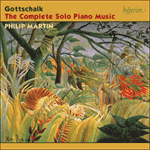A characteristic rhythmic figure in the mazurkas of Chopin is a dotted quaver and semiquaver on the first beat of the (34) bar followed by two crotchets: Op 30 No 2 in D flat and Op 7 No 5 in B flat, for example. (The latter, it might be noted, is dedicated to ‘Monsieur Johns de Nouvelle Orléans’, a ‘distinguished amateur from New Orleans’ as Chopin described him when introducing him to Heller … so Louis Moreau was not, then, the first pianist from his home town to make an impression in Paris.) After an introduction of fourteen bars, Gottschalk’s gracefully playful theme emerges, a young man’s homage to the Polish master. E flat gives way to a central section in A flat before an octave repeat of the initial subject decorated with typical Gottschalkian étincelles in the upper reaches of the keyboard.
La Scintilla was first published in New York in 1854.
from notes by Jeremy Nicholas © 2000
L’une des figures rythmiques caractéristiques des mazurkas de Chopin est une croche pointée et une double croche sur le premier temps de la mesure (34), suivies de deux noires—cf., par exemple, l’op. 30 no2 en ré bémol et l’op. 7 no5 en si bémol (lequel est, soit dit en passant, dédié à «Monsieur Johns de Nouvelle-Orléans», que Chopin présenta à Heller comme un «amateur émérite de la Nouvelle-Orléans» … preuve que Louis Moreau ne fut pas le premier pianiste de cette ville à faire impression à Paris). Passé une introduction de quatorze mesures, le thème gracieusement espiègle de Gottschalk émerge, hommage d’un jeune homme au maître polonais. Mi bémol cède la place à une section centrale en la bémol, avant une reprise, à l’octave, du sujet initial, décoré d’étincelles typiquement gottschalkiennes, dans le haut du clavier.
La Scintilla parut à New York en 1854.
extrait des notes rédigées par Jeremy Nicholas © 2000
Français: Hypérion
Eine charakteristische rhythmische Figur der Mazurken Chopins ist eine punktierte Achtel- und Sechzehntelnote auf dem ersten Schlag des (34-)Takts, gefolgt von zwei Viertelnoten: zum Beispiel Op. 30 Nr. 2 in Des-Dur und Op. 7 Nr. 5 in B-Dur. (Es mag von Interesse sein, daß die letztgenannte Mazurka „Monsieur Johns de Nouvelle Orléans“ gewidmet sind, einem „angesehenen Amateur aus New Orleans“, wie Chopin ihn Stephen Heller vorstellte … Louis Moreau war demzufolge nicht der erste Pianist seiner Heimatstadt, der in Paris Eindruck machte.) Nach einer vierzehn Takte umfassenden Einleitung kommt Gottschalks anmutig verspieltes Thema zum Vorschein, die Huldigung eines jungen Mannes an den polnischen Meister. Es-Dur weicht einem Mittelteil in As-Dur, bevor eine oktavische Wiederholung des ersten Themas, verziert mit typisch Gottschalkschen
étincelles (Funken) in den oberen Regionen der Klaviatur erklingt.
La Scintilla erschien erstmals 1854 in New York.
aus dem Begleittext von Jeremy Nicholas © 2000
Deutsch: Anne Steeb/Bernd Müller


 Gottschalk: The Complete Solo Piano Music
Gottschalk: The Complete Solo Piano Music
